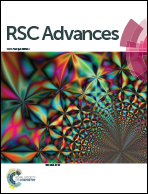Stability of metal oxides against Li/Na carbonates in composite electrolytes
Abstract
Solid oxide–alkaline carbonate (Li2CO3 : Na2CO3, 1 : 1 molar ratio) composite electrolytes were prepared using different solid oxide matrices (TiO2, HfO2, Yb2O3, Y2O3, Dy2O3, Gd2O3 and La2O3), to cover a wide range of ceramic chemical characteristics. The chemical and microstructural stability of these oxides with the mixed carbonates were studied by powder X-ray diffraction, scanning electron microscopy, infrared and laser Raman spectroscopic techniques after reacting them at 690 °C for 1 h in air. The electrical performance of selected composites was evaluated using impedance spectroscopy, in air. Amongst the oxides hereby tested, TiO2 is found to be the most unstable in contact with the molten carbonates whereas Yb2O3 is quite stable. The corresponding composites have ionic conductivities (3.3 × 10−1 S cm−1 at 580 °C, in air) close to those reported for state-of-the-art ceria-based composite electrolytes. A draft equivalent circuit model underlines the transport in the carbonate phase and across the carbonate/oxide interfaces as the dominant contributions to the total conductivity of these composites. Yb2O3 + Li2CO3 : Na2CO3 composites show chemical stability at operating temperatures in the order of 690 °C, standing as a potential candidate for intermediate temperature applications.


 Please wait while we load your content...
Please wait while we load your content...